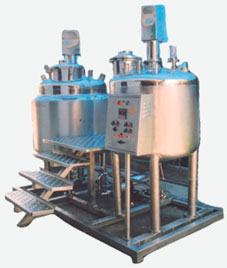VValfit Engineers is an engineering company which handles diversified activities in the field of engineering-like designing, manufacturing & supplying of Machineries & Process Equipment, Tanks & Jacketed Vessels, U.V. Systems & Heat Exchangers , Water Distribution Skids, Pumps, Pneumatic Valves, Butterfly Valves, Ball Valves, Flush Bottom Valves, FDV, Sampling Valves, Micron Filters/ Conical Filters/ Filter Cartridges, Pipes & Fittings.
Valfit Engineers also manufacture customized Distribution Skid, Multicolumn Distribution Skid, Pure Steam Generator, WFI Distribution Skid, Pw Skid With Heat Exchanger, Liquid Manufacturing Plant as per the technical specification requirement from the customers.

A Storage Tank is a container used to hold liquids, gases, or other materials for various industrial, commercial, agricultural, or residential applications. Storage tanks come in a wide range of sizes, materials, and configurations, tailored to meet specific requirements based on the type of substance stored, environmental conditions, and regulatory standards.
Storage tanks are vital components across various industries, enabling the safe and efficient storage of a wide range of substances. Understanding the different types, materials, design considerations, and regulatory requirements is essential for selecting the appropriate storage solution. Regular maintenance and adherence to safety standards ensure the longevity and reliability of storage tanks, safeguarding both the stored materials and the surrounding environment.
Types of Storage Tanks
Steel Tanks: Commonly used for oil, chemicals, and water storage. They can be carbon steel or stainless steel, depending on corrosion resistance needs.
Plastic Tanks: Made from materials like polyethylene (PE) or fiberglass-reinforced plastic (FRP). Suitable for water, chemicals, and some food products.
Concrete Tanks: Often used for large-scale water storage, wastewater treatment, or fuel storage.
Fiberglass Tanks: Lightweight and corrosion-resistant, ideal for chemicals and potable water
Aboveground Tanks: Installed above the ground; easier to inspect and maintain. Common in fuel stations and industrial sites.
Underground Tanks: Buried below the surface; used when space is limited or for aesthetic reasons. Often used for fuel storage.
Vertical Tanks: Cylindrical in shape, ideal for large volumes and easy manufacturing.
Horizontal Tanks: Longer and lower profile; used where height is restricted.
Fixed Roof Tanks: Permanent structures with a fixed covering.
Floating Roof Tanks: Roofs that rise and fall with the liquid level, reducing vapor emissions. Common in oil storage.
Double-Wall Tanks: Have an additional layer for secondary containment, enhancing safety against leaks.
Environmental and Safety Considerations:
Proper management of storage tanks is essential to minimize environmental impact and ensure safety:
• Leak Prevention: Implementing double-walled tanks and leak detection systems to prevent spills.
• Vapor Control: Using floating roofs or vapor recovery systems to reduce emissions.
• Emergency Response Plans: Having strategies in place for spills, fires, or other emergencies.
• Training: Ensuring personnel are trained in tank operations, safety protocols, and emergency procedure
Common Applications:
• Petroleum and Chemicals: Storage of crude oil, gasoline, diesel, and various chemicals.
• Water and Wastewater: Municipal water supply, rainwater harvesting, and wastewater treatment.
• Agriculture: Storage of fertilizers, pesticides, and irrigation water.
• Food and Beverage: Holding ingredients like milk, syrup, and other consumables.
• Industrial Processes: Storing raw materials, intermediates, and finished products.
